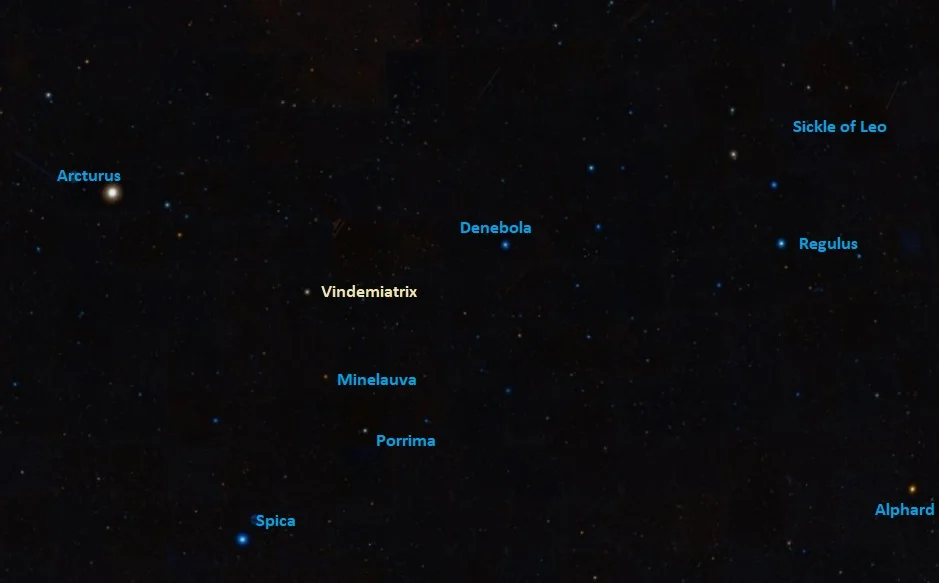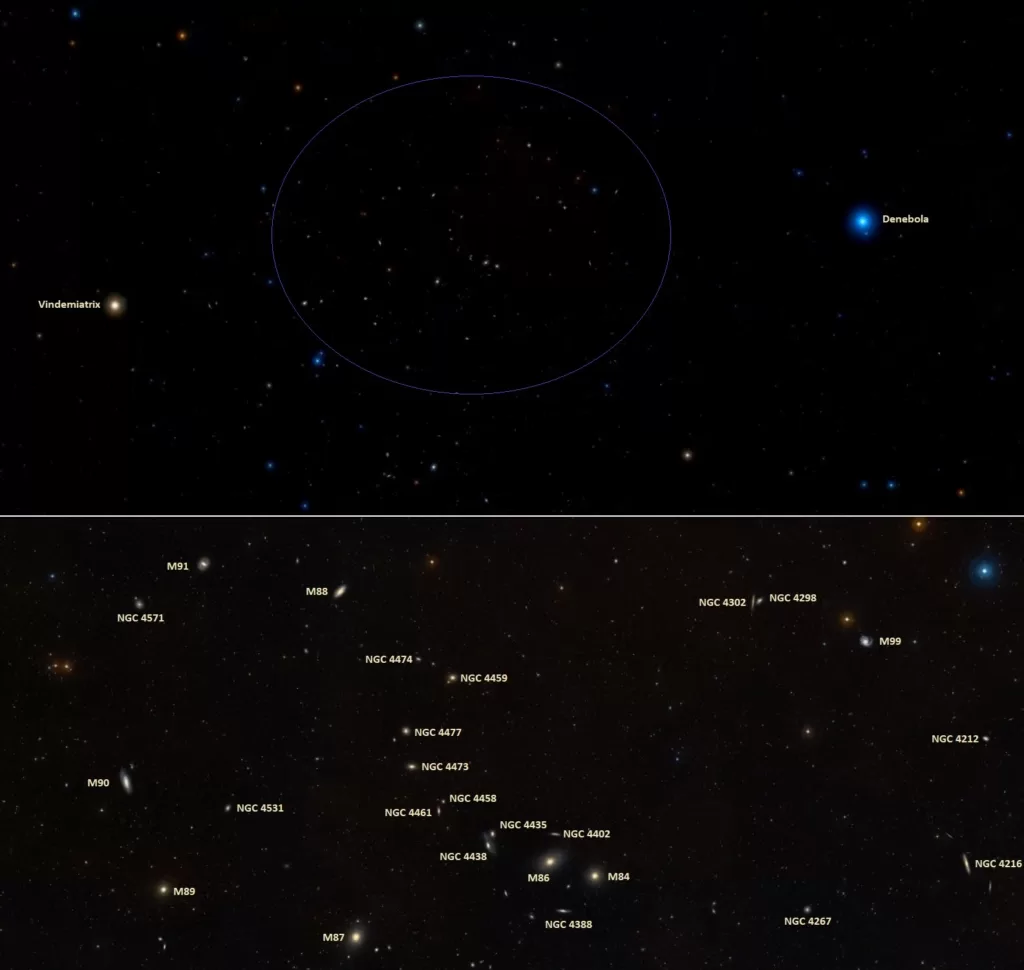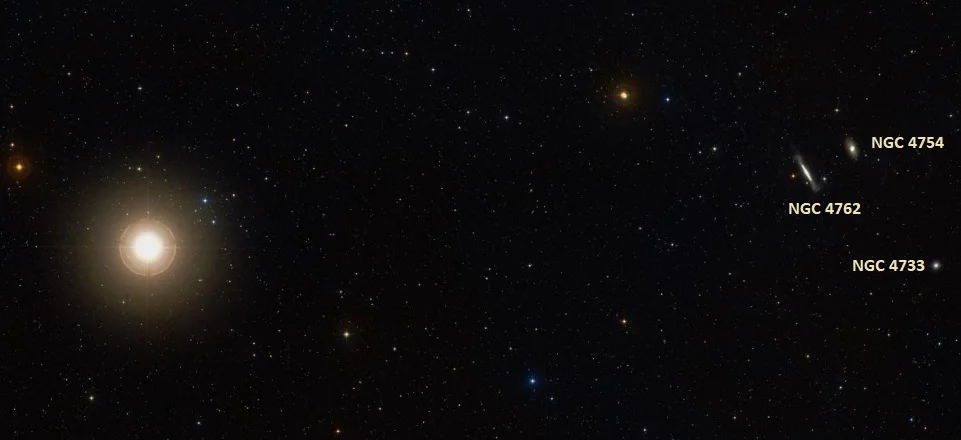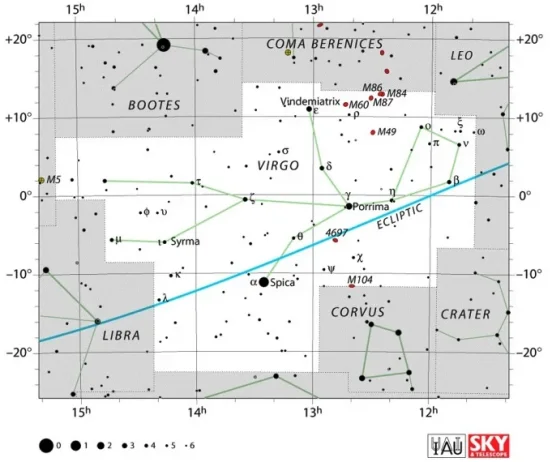Vindemiatrix, Epsilon Virginis (ε Vir), is a yellow giant star located in the constellation Virgo. With an apparent magnitude of 2.826, it is the third brightest star in Virgo, after Spica and Porrima. Vindemiatrix lies at a distance of 109.6 light years from Earth. The star is well known to stargazers because, together with Denebola in Leo, it is used to find the Virgo Cluster of galaxies.
Star type
Vindemiatrix is a yellow giant of the spectral type G8 III. It has a mass 2.64 times that of the Sun and a radius 10.6 times solar. With an effective temperature of 5,086 K, it is 77 times more luminous than the Sun. The star is a slow spinner. With a projected rotational velocity of 2.3 km/s, it takes 173 days to complete a rotation. The star’s estimated age is 560 million years.
Vindemiatrix is a strong X-ray source. The X-ray emission indicates the presence of magnetic fields that affect the heating of the coronal plasma. The star’s total X-ray output is 300 times that of the Sun.

Vindemiatrix (Epsilon Virginis), image: Wikisky
Facts
The spectrum of Vindemiatrix has been used as a stable anchor point for the Morgan-Keenan system of spectral classification since 1943. The MK classification system is used to classify stars based on the appearance of their spectra.
Vindemiatrix is believed to be a member of the Milky Way thin disk population. Stars in the thin disk typically have orbits that keep them close to the galactic plane. The orbit of Vindemiatrix does not depart more than 200 light years from the plane.
Name
The name Vindemiatrix (pronunciation: /vɪndiːmiˈeɪtrɪks/) comes from the Latin vindēmiātrix, meaning “the grape-harvestress.” In ancient times, the star was also traditionally known as Vindemiator (“grape-harvester”), Vindemitor, Provindemiator and Provindemia Major. The names refer to the star’s heliacal rising (the first visible rising before sunrise after a period of invisibility) signalling the beginning of the grape picking season in ancient times.
The name Vindemiatrix was formally approved by the International Astronomical Union’s (IAU) Working Group on Star Names (WGSN) on July 20, 2016.
Epsilon Virginis was also historically known as Alaraph, Almuredin, Al Mureddin, Alcalst, Almucedie Protrigetrix and Protrygetor.
In Arabic astronomy, Vindemiatrix, Zavijava (Beta Virginis), Zaniah (Eta Virginis), Porrima (Gamma Virginis) and Minelauva (Delta Virginis) formed an asterism called Al ʽAwwāʼ, meaning “the Barker.”
The Chinese know Vindemiatrix as 太微左垣四 (Tài Wēi Zuǒ Yuán sì), the Fourth Star of Left Wall of Supreme Palace Enclosure. The Left Wall of Supreme Palace Enclosure is a Chinese asterism formed by Vindemiatrix, Zaniah, Porrima, Minelauva and Diadem (Alpha Comae Berenices). The Supreme Palace Enclosure is one of the Three Enclosures in Chinese astronomy. It represents the imperial court. Vindemiatrix represents the Second Eastern General.
Location
Vindemiatrix is easy to find because it is relatively bright and located near the centre of a triangle formed by the bright Arcturus, Spica and Denebola. Arcturus and Spica are found along the imaginary curved line extended away from the handle of the Big Dipper, while Denebola marks the tail of the celestial Lion and appears just left of the Sickle of Leo, an asterism that outlines the Lion’s mane. The Sickle appears as a backward question mark, with the bright Regulus sitting at the base.

Vindemiatrix location, image: Wikisky
Vindemiatrix and Denebola can be used to find the Virgo Cluster, whose centre appears halfway between the two bright stars.

Denebola, Vindemiatrix and the Virgo Cluster, image: Wikisky
Markarian’s Chain, a striking string of galaxies stretching over more than a degree, appears almost exactly between the two stars. It includes the bright galaxies Messier 84, Messier 86, and the Eyes Galaxies (NGC 4435 and NGC 4438).

Markarian’s Chain, image: Wikisky
Relatively bright galaxies that appear near Vindemiatrix include the edge-on lenticular galaxy NGC 4762 and the barred lenticular galaxies NGC 4754 and NGC 4733. The galaxies have apparent magnitudes of 11.12, 11.52 and 12.7 respectively.

Vindemiatrix, NGC 4754, NGC 4762 and NGC 4733, image: Wikisky
Constellation
Vindemiatrix is located in the constellation Virgo. Virgo is the second largest constellation in the sky, after Hydra. It stretches across 1,294 square degrees of the sky along the ecliptic. It is one of the 48 Greek constellations, first catalogued by the Greek astronomer Ptolemy in the 2nd century CE.
Virgo contains many notable stars, including Spica, the 16th brightest star in the sky, the red giant Minelauva (Delta Virginis), the orange giant Kang (Kappa Virginis), and the Sun-like star 61 Virginis, which hosts three planets.

Virgo constellation map by IAU and Sky&Telescope magazine
The constellation is home to the Virgo Cluster, the nearest large galaxy cluster to the Milky Way. The cluster contains at least 1,300 galaxies, many of them bright enough to be observed with backyard telescopes. The brightest members include the elliptical galaxy Messier 49, the supergiant elliptical Messier 87 (Virgo A), home to the first imaged black hole, the grand design spiral galaxy Messier 100, and the pairs NGC 4435 and NGC 4438 (the Eyes Galaxies) and NGC 4567 and NGC 4568 (the Butterfly Galaxies).
Virgo also contains the bright Sombrero Galaxy (Messier 104) and the supergiant elliptical galaxy IC 1101, one of the largest galaxies known.
The best time of year to watch the stars and deep sky objects in Virgo is during the month of May, when the constellation is prominent in the evening sky. Virgo is visible from most inhabited places on Earth. The entire constellation can be seen from locations between the latitudes 80° N and 80° S.
The 10 brightest stars in Virgo are Spica (Alpha Vir, mag. 0.97), Porrima (Gamma Vir, mag. 2.74), Vindemiatrix (Epsilon Vir, mag. 2.826), Heze (Zeta Vir, mag. 3.376), Minelauva (Delta Vir, mag. 3.39), Zavijava (Beta Vir, mag. 3.604), 109 Virginis (mag. 3.72), Mu Virginis (mag. 3.88), Zaniah (Eta Vir, mag. 3.89), and Nu Virginis (mag. 4.04).
Vindemiatrix – Epsilon Virginis
| Spectral class | G8 III |
| U-B colour index | +0.718 |
| B-V colour index | +0.940 |
| Apparent magnitude | 2.826 |
| Absolute magnitude | 0.37 ± 0.06 |
| Distance | 109.6 ± 0.5 light years (33.6 ± 0.2 parsecs) |
| Parallax | 29.76 ± 0.14 mas |
| Radial velocity | -14.29 ± 0.02 km/s |
| Proper motion | RA: -273.80 ± 0.13 mas/yr |
| Dec.: +19.96 ± 0.09 mas/yr | |
| Mass | 2.64 ± 0.11 M☉ |
| Luminosity | 77 L☉ |
| Radius | 10.6 ± 0.3 R☉ |
| Temperature | 5,086 K |
| Metallicity | +0.09 dex |
| Age | 560 ± 90 million years |
| Rotational velocity | 2.3 km/s |
| Rotation | 173 days |
| Surface gravity | 2.71 ± 0.04 cgs |
| Constellation | Virgo |
| Right ascension | 13h 02m 10.5978496s |
| Declination | +10° 57′ 32.941443″ |
| Names and designations | Vindemiatrix, Alaraph, Almuredin, Protrigetrix, Protrygetor, Provindemiator, Vindemiator, Epsilon Virginis, ε Vir, 47 Virginis, HD 113226, HR 4932, HIP 63608, FK5 488, SAO 100384, PPM 129529, GC 17687, GCRV 7772, BD+11°2529, AG+11 1470, LTT 13759, NLTT 32663, JP11 2348, PLX 2987.00, IRAS 12596+1113, 2MASS J13021059+1057329, UBV 11767, TYC 886-1326-1, Gaia DR2 3736865265439463424, CCDM J13022+1057A, IDS 12572+1130 A, WDS J13022+1058A |